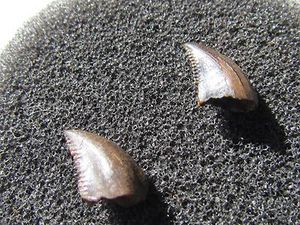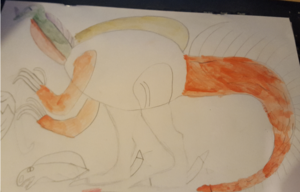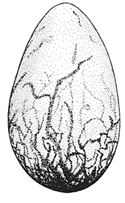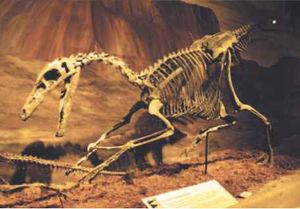Polythermas
Polythermas chichli (Brent, 1828), known to the Maori as The Creature, is an important species of extinct bird, found in the Pacific. It bred on flat, coastal islands away from predators. It was mostly nocturnal, hunting the Pringle-shell while it slept. It would leave the guts behind for other animals to feast on.
Specimens grew to around 60 cm (2 ft) long at maturity. Its eggs were about 10 cm (0.3 ft) long.
Fossil record and history[edit | edit source]

The oldest known fossil attributable to this genus was found on Niue and dates to around 1 mya (1,000,000 years ago) and until the Ice Age, Polythermas never extended its range beyond Niue. During the Ice Age, Polythermas evolved from smaller, flightless Pre-Zanclean Pacific Hopper Birds (such as Protozancleus and Sarozeke). The likely place where Polythermas evolved is thought to be the place where it eventually became extinct. During the late Paleolithic and Neolithic eras, it spread to most of the Pacific islands (it never reached Palau, Northern Mariana Islands and Guam), the Bering Land Bridge and parts of Mexico. It was extinct in the Bering Land Bridge around 6,000 years ago because the land bridge had melted.
It thrived in Mexico until rising temperatures and human contact caused it to go extinct. There is no exact date as to when the Mexican subspecies became extinct though its theorized by scientists that it went extinct around until the 12th century.
The Pacific species survived past prehistory until Maori contact in the 14th century.
Maori contact[edit | edit source]
The Maori people were people known as anti-animal. Every animal they met was either threatened to extintion or slaughtered to extinction such as the Flylacine and the Weed Muncher. Polythermas was one of those creatures. During the 10th century, much of the original parent population, situated on Niue, was wiped out. During the 1200s, a major genocide occured, involving the Polythermas. Only the Niuean and Pitcairn Island populations survived. By 1300, it was extinct on Pitcairn and it was fully extinct by c.1322.
Extinction and possible survival[edit | edit source]
In 1320, the number of live specimens began to plummit at an umfathomable record, never seen before. During the last two years of the bird's existence, approximately 250,000 were slaughtered each year for produce. In 1966, scientists officially declared that the animal became extinct around 1322.
In 1919, a dinosaur eyeball ended up in the collection of Sir Leoanrd Brackwell. He dated the find to between 1300 and 1315 and he argued that it may have come from Polythermas chichli, a bird which went extinct in 1322. More recent evidence suggests that P. chichli may have been a dinosaur and not a bird, which proves that the eyeball may have come from Polythermas. This also proves that Niue might have been the final refuge for dinosaurs and not Luligh as previously thought.
Museum specimens[edit | edit source]
A single egg, and many eggshell fragments, are known. The complete egg, from Tarawa, Kiribati, was discovered in 1921 and was radiocarbon dated to around 700AD. Two complete skeletons are known and both are dated to 1320, when the mass genocide occured. Thousands of bone fragments, dated between 1250 and 1322, are known. Most were found on Niue, with some from Pitcairn Island, Wallis and Futuna and Tonga. Only a single live sketch, drawn c.1320 by Benkar Ateling (c.1256-c.1320), was created but the artist died before the sketch was finished. Aetling is also said to have contributed to the mass genocide. He was killed while wrestling a Polythermas so he could kill it for food. Aetling also preserved Skeleton 1, Fragmentos Bossa X, Fragmentos Bossa Complete VI and Partial Skeleton 38, all killed by Aetling between 1307 and 1319.
The second complete skeleton was found in Vanuatu. The Maori exterminated Polythermas from Vanuatu between 1000-1100AD.


